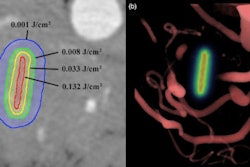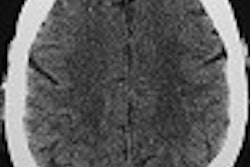Mangafodipir trisodium-enhanced MRI is superior to contrast-enhanced helical hydro-CT for the detection of small pancreatic masses and liver metastases, according to researchers from Austria and the U.S. The group compared the two modalities for the diagnosis and staging of pancreatic cancer.
"A surgeon’s ability to successfully treat a patient with pancreatic cancer depends on the ability and diagnostic accuracy of imaging techniques to detect small tumors that do not disrupt the contour of the organ and reliably characterize tumor resectability," wrote lead author Dr. Wolfgang Schima in the American Journal of Roentgenology (September 2002, Vol. 179:3, pp. 717-724).
Schima, as well as several of the other authors, were from the University of Vienna; one author, Dr. Mark Ryan, came from the Duke University Medical Center in Durham, NC.
Patients with small malignancies (less than or equal to 2 cm in diameter) have the best prognosis, and helical CT has been the standard imaging technique for assessing pancreatic cancer. More recently, helical hydro-CT has been used in conjunction with the oral administration of water and IV administration of hyoscine-N-butyl bromide in order to reduce peristalsis, the authors said.
"Mangafodipir trisodium is a new organ-specific contrast agent that was originally developed for MR imaging of the liver...uptake of mangafodipir trisodium (Teslascan, Amersham Health, Oslo, Norway) also occurs in the pancreatic parenchyma but not in pancreatic tumors, leading to improved conspicuity of pancreatic cancers," they wrote.
Forty-two patients were enrolled in the study. The final diagnosis was cancer in 26 patients; the mean lesion size was 3.7 cm. MRI was performed on one of two units: The 1.5-tesla Magnetom Vision scanner (Siemens Medical Solutions, Erlangen, Germany) or the Gyroscan ACS-NT (Philips Medical Systems, Best, the Netherlands). A phased-array torso coil was used, as well as nearly identical imaging parameters. Over a 10-15 minute period, 10 μmol/kg of mangafodipir trisodium was given by IV to all patients.
CT images were acquired using either the Tomoscan AVE1 scanner from Philips or the Somatom Plus 4 from Siemens. Unenhanced scans of the liver and pancreas were obtained, as well as dual-phased contrast-enhanced scans. Before scanning, 750-1,000 mL of water was administered orally as a contrast agent, and 20 mg of Buscopan (Boehringer Ingelheim, Ingelheim, Germany) was given by IV to reduce peristaltic artifact.
Two radiologists who were blinded to the results evaluated the images. Tumor size was determined by measuring the hypodense or hypointense area on CT and MRI, and was rated on a 5-point confidence scale (1 = definitely present; 5 = definitely absent). CT or MR imaging evidence of vascular compromise was defined as vessel occlusion or invasion. Tumors were deemed unresectable when enlarged distant lymph nodes, liver metastases, or peritoneal implants were present. Lesions were characterized as benign or malignant using a 5-point scale (1= definitely resectable; 5=definitely nonresectable).
The results were as follows: For tumor detection and characterization, mangafodipir trisodium-enhanced MRI detected all masses, for a sensitivity of 100%. Contrast-enhanced helical CT detected 34 of 36 lesions, for a sensitivity of 94%.
For the differentiation of pancreatic adenocarcinoma from nonadenocarcinoma, MR had a sensitivity of 100%, a positive predictive value (PPV) of 90%, and a negative predictive value (NPV) of 100%. CT had a sensitivity of 92%, a PPV of 80%, and an NPV of 67%.
For tumor resectability, MR enabled the correct diagnosis of resectability in 9 patients and nonresectability in 14 patients. The sensitivity for diagnosing nonresectability was 90%, and the specificity was 93%. CT correctly found 9 patients’ cancer to be resectable and 12 patients nonresectable, for a sensitivity of 80% and a specificity of 60%.
On MR, there were three cases of false-positive diagnoses of cancer; on CT, there were six. In summary, the researchers found MRI superior to CT for the detection of liver metastases, and better for tumor delineation and diagnostic confidence. In addition, mangafodipir trisodium-enhanced MR depicted all seven small pancreatic metastases, suggesting that it is better for pinpointing small malignancies.
However, CT bested MRI for the assessment of vascular invasion, "one of the most difficult issues in imaging patients with pancreatic cancer," they said. MRI did not reveal vascular encasement, which can improve pancreatic cancer staging. On the other hand, CT displayed the presence of duodenal invasion because the "duodenum can be distended after peroral administration of (water)." MRI would only prove valuable in these cases if an expensive contrast agent was used, they added.
One of the limitations of the study was the small number of patients with resectable tumors, Schima and colleagues wrote. Another was that the images were analyzed on conventional hard-copy films; a cine display of multiple CT and MR images would make reading easier.
Finally, neither modality fared well for the differentiation of pancreatic adenocarcinoma from other conditions. The authors cautioned that "because pancreatic tumors with equivocal findings on CT or MR imaging are potentially resectable, an important clinical concern is that these patients not be denied surgery," they said.
By Shalmali PalAuntMinnie.com staff writer
September 16, 2002
Related Reading
Photodynamic therapy shows promise as treatment for pancreatic cancer, April 15, 2002
CT, MRI helps pinpoint rare pancreatic alteration cystic fibrosis patients, March 5, 2001
MR beats CT in pancreatic cancer staging, March 3, 2001
Mangafodipir-enhanced MRI performs well in pancreas, March 7, 2000
Copyright © 2002 AuntMinnie.com


















